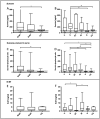Diagnostic value of serum survivin, Ki-67 and thymidine kinase in dogs with nasal cavity disease
- PMID: 40260215
- PMCID: PMC12009801
- DOI: 10.3389/fvets.2025.1553551
Diagnostic value of serum survivin, Ki-67 and thymidine kinase in dogs with nasal cavity disease
Abstract
Background: The most common nasal cavity disease (ND) in dogs is the malignant nasal cavity tumor. Prognosis and survival after radiation therapy are reported to correlate with tumor size, and therefore indirectly with the time to diagnosis. Diagnosis of a nasal tumor requires imaging procedures under anesthesia. Thus, diagnostic serum markers are urgently needed for early detection and for therapeutic monitoring.
Materials and methods: This prospective, blinded study included dogs with nasal discharge that completed a comprehensive diagnostic workup for ND. Dogs were evaluated by blood testing and whole-body CT and those with concomitant diseases or with steroid pre-treatment were excluded. Serum survivin, Ki-67, and thymidine kinase 1 (TK1) concentrations were determined, and the survivin-lymphocyte ratio (SLR) calculated. Results were compared between groups of dogs with different NDs and to ten healthy controls.
Results: A total of 55 dogs were included, consisting of 25 with malignant ND (12 sarcomas, 13 carcinomas) and 30 with benign ND (7 benign tumors, 13 dogs with idiopathic rhinitis (IR), 10 others including dogs with dental diseases and sinonasal aspergillosis). Survivin and SLR were significantly increased in dogs with malignant ND and in subgroup comparison in sarcomas compared to controls. In addition, the SLR was significantly increased in carcinomas and IR compared to controls. In dogs with IR, no differences were observed in survivin concentrations or SLR based on microbiological or histopathological findings. Survivin concentrations or SLR in dogs with nasal tumors were not significantly different between T-categories. No significant differences were detected in TK1 concentrations among the groups, nor in Ki-67, except for significantly lower Ki-67 concentrations in benign tumors compared to carcinomas and the group others including, e.g., dental diseases.
Conclusion: Although not diagnostic for ND, increased survivin serum concentrations or SLR can be detected in dogs with malignant nasal tumors and IR. In malignant nasal tumors, survivin and SLR did not correlate with tumor size and therefore may be useful in the detection of even small nasal tumors. Therefore, in dogs with nasal tumors and IR, survivin and SLR could serve as a target for disease monitoring or as therapeutic target.
Keywords: blood marker; carcinoma; lymphoplasmacytic rhinitis; nasal discharge dog; nasal neoplasia; sarcoma.
Copyright © 2025 Rösch, Estaller, Oechtering and Neumann.
Conflict of interest statement
The authors declare that the research was conducted in the absence of any commercial or financial relationships that could be construed as a potential conflict of interest.
Figures




Similar articles
-
Diagnostic Utility of Canine C-Reactive Protein, Haptoglobin, and 25-Hydroxyvitamin-D in Dogs with Nasal Cavity Disease.Animals (Basel). 2024 Oct 9;14(19):2908. doi: 10.3390/ani14192908. Animals (Basel). 2024. PMID: 39409857 Free PMC article.
-
Diagnostic benefits of platelet-to-lymphocyte, neutrophil-to-lymphocyte, and albumin-to-globulin ratios in dogs with nasal cavity diseases.BMC Vet Res. 2024 Feb 3;20(1):44. doi: 10.1186/s12917-024-03876-5. BMC Vet Res. 2024. PMID: 38310231 Free PMC article.
-
Expression of vascular endothelial growth factor receptor-2, epidermal growth factor receptor, cyclooxygenase-2, survivin, E-cadherin and Ki-67 in canine nasal carcinomas and sarcomas - a pilot study.Front Vet Sci. 2024 Aug 29;11:1388493. doi: 10.3389/fvets.2024.1388493. eCollection 2024. Front Vet Sci. 2024. PMID: 39268521 Free PMC article.
-
Spontaneous tumors in dogs and cats: models for the study of cancer biology and treatment.Cancer Metastasis Rev. 1990 Sep;9(2):125-36. doi: 10.1007/BF00046339. Cancer Metastasis Rev. 1990. PMID: 2253312 Review.
-
Canine nasal aspergillosis.Clin Tech Small Anim Pract. 2006 May;21(2):82-8. doi: 10.1053/j.ctsap.2005.12.015. Clin Tech Small Anim Pract. 2006. PMID: 16711614 Review.
References
-
- Auler Fde A, Torres LN, Pinto AC, Unruh SM, Matera JM, Stopiglia AJ. Tomography, radiography, and Rhinoscopy in diagnosis of benign and malignant lesions affecting the nasal cavity and paranasal sinuses in dogs: comparative study. Top Companion Anim Med. (2015) 30:39–42. doi: 10.1053/j.tcam.2015.06.002, PMID: - DOI - PubMed
LinkOut - more resources
Full Text Sources

